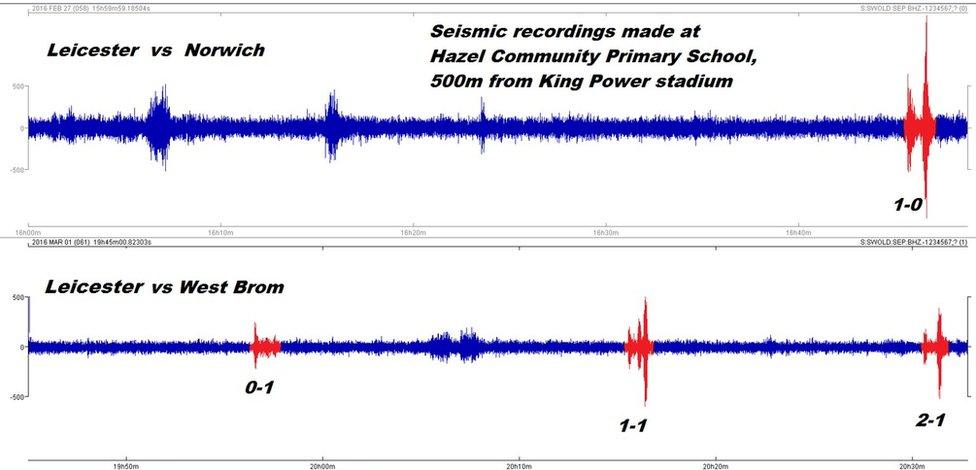Leicester City fans caused 'earthquake' after last minute winner
- Published

Leonardo Ulloa scored a dramatic last minute winner against Norwich City on 27 February
An "earthquake" made by football fans celebrating a goal has been recorded for the first time in the UK.
A University of Leicester team installed a seismometer near Leicester City's King Power stadium and reported a minor quake with a magnitude of 0.3.
The tremor was attributed to a "sudden energy release" made by Foxes fans when Leonardo Ulloa scored a last-minute winner against Norwich, in February.
The event has been labelled the "Vardy Quake" after top scorer Jamie Vardy.
Live updates and more from Leicestershire
A seismometer was installed by geology students, and the British Geological Survey (BGS), at Hazel Community Primary School, 500m (0.3 miles) from the King Power Stadium, as part of a project to detect earthquakes around the world.

The spike (in red) was caused by the late goal against Norwich while goals scored against West Brom were of a lower magnitude
However, Paul Denton, a seismologist from the BGS, said the team wondered if football fans would affect the detectors.
He said: "The seismometers were actually closer to the Leicester Tigers [rugby] ground and so we were expecting stronger signals from there but we can't find anything.
'Awful amount of energy'
"It says something about the nature of football, it's so tense and then we get four or five seconds of unexpected magic.

Leicester City fans have been credited with helping their team hit the top of the Premier League
"[In Leicester's case] it was in the 89th minute, the game was practically over.
"It wasn't just a case of cheering or clapping, it was 30,000 people standing up at the same time - an awful amount of energy."
The scientist who recorded similar results at the Reading music festival and freight trains passing through the city, said he would like to see how Leicester compares with other football clubs.
He said it could inspire children to get more interested in science.

University of Leicester students will be monitoring whether fans can beat the 0.3 magnitude recorded against Norwich
Leicester City have been the surprise package in the Premier League this season and are clear at the top by five points with nine games left to play.
The students will continue to monitor the Foxes' home games and will provide updates via the @VardyQuake, external Twitter account.
- Published26 February 2016

- Attribution
- Published4 March 2016
